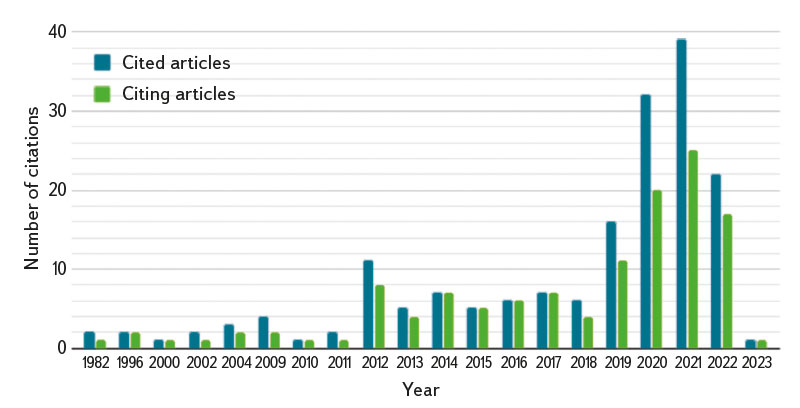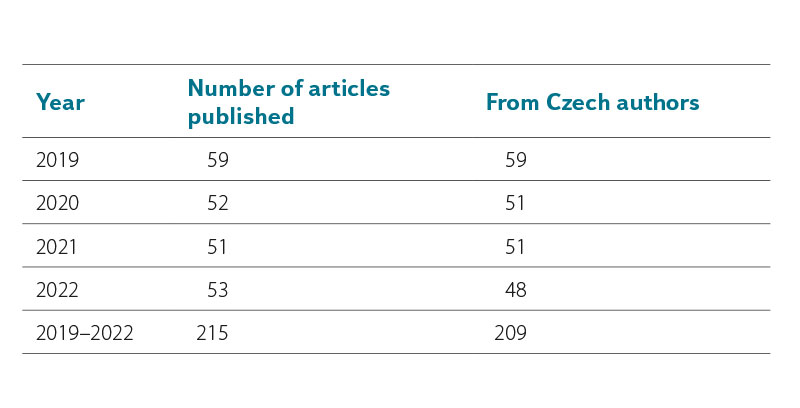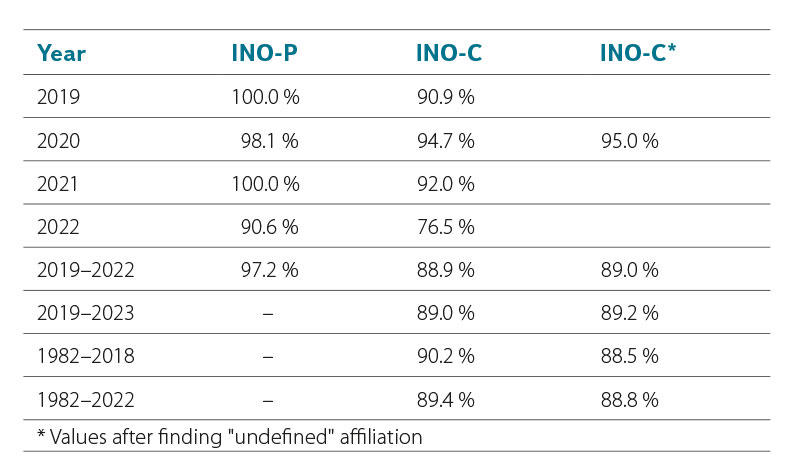ABSTRACT
The article describes an analysis of the national orientation of the Vodohospo-dářské technicko-ekonomické informace (VTEI) journal using the bibliometric indicator Index of National Orientation (INO). This analysis builds on a citation analysis performed in 2022. Based on data on published articles, the Index of National Orientation of Publishing Authors (INO-P) is calculated. For VTEI journal citations in the Scopus database, the Index of National Orientation of Citing Authors (INO-C) is calculated. The analysis shows that again there has been an increase in the number of citations recorded in the Scopus database, although the number of citations for 2022 is slightly lower than in 2021 and 2020. The values of both INO-P and INO-C show that both the publishing authors and the citing authors mainly come from the Czech Republic, and the VTEI journal thus falls into the category of national journals. In 2022, there is a decrease in the values of both INO-P and INO-C, i.e., a shift towards the internationalization of the VTEI journal. However, it remains to be seen in the following years whether these are statistically outlying values or whether this marks the beginning of a trend towards internationalization of the journal.
INTRODUCTION
Last year’s article [1] presented a citation analysis of the VTEI journal, which identified 108 citations from authors from a total of 16 countries. However, it did not contain any quantitative expression of the VTEI journal (inter)nationality. Monitoring of the VTEI journal citations continues; as of 16/02/2023, 126 articles citing the VTEI journal by authors from 22 countries (excluding the Czech Republic) can be found in the Scopus database. Does this increase mean that VTEI journal is going international? The way a journal reflects the internationalized nature of science can be determined by many methods [2]. In 2005, Moed introduced a new bibliometric indicator called the Index of National Orientation (INO). This indicator is defined as “the share of articles from the country that most often publishes in the journal, relative to the total number of articles published in the journal” [3]. A purely national journal will have an INO index = 100 %. Subsequently, the concept of the Index of National Orientation was extended to the Index of National Orientation by Country of Publishing Authors (INO-P) and the Index of National Orientation by Country of Authors Citing the Journal (INO-C) [4]. In the study by Hladchenko and Moed [5], the level above which a journal will be considered national is expressed by a value of the Index of National Orientation of Publications (INO-P) greater than 50 %.
The advantage of the INO bibliometric indicator is the relative simplicity of its determination. In connection with the Scopus bibliometric database [6], the INO indicator can be calculated only on the basis of information displayed via the web interface with the help of a calculator. On the other hand, it should be noted that the simplicity of determining the indicator is compensated by some limitations. One of the possible limitations of the INO indicator in connection with Scopus data is the possibility of missing data on the author’s country. To solve this problem, Moed et al. [7] suggested not to include articles without author affiliation in the total number of articles, i.e., divide the number of articles published from the author’s most productive country by the number of articles for which at least one author’s country of origin is available in the database.
This article presents the updated citation values of the VTEI journal in the Scopus database. Simultaneously, the values of the INO bibliometric indicator were calculated both for published articles (INO-P) and especially for citing articles (INO-C).
DATA AND METHODS
The basic search query that is used to find articles in the Scopus database:
REF (“technicko-ekonomick* inf*”) Or REF (“Vodohosp* techn*”) Or REF (“Wat* manag* tech* econ* inf*”) Or REF (“Wat* manag* tech* and econ* inf*”) Or REF (vtei) Or REF (“Vodoh* Tech.-Ekon* Inf*”)
This query returned a total of 148 results as of the data collection date (16/02/2023), which were checked to see if they actually contained a citation to the VTEI journal or not. Records that do not cite articles in the VTEI journal were excluded from these results. These were citations containing, for example, “vtei.edu.ua” (5x), “bulletin technicko-ekonomických informací” (4x), “vtei.com” (3x), “Virtually Transparent Epidermal Imagery (VTEI)” (3x), etc.
In order to obtain data for calculating INO-C from Scopus, a final query was prepared in the following form:
REF (“technicko-ekonomick* inf*”) Or REF (“Vodohosp* techn*”) Or REF (“Wat* manag* tech* econ* inf*”) Or REF (“Wat* manag* tech* and econ* inf*”) Or REF (vtei) Or REF (“Vodoh* Tech.-Ekon* Inf*”) AND NOT (EID (2-s2.0-85118100770) Or EID (2-s2.0-85119513282) Or EID (2-s2.0-85085736011) Or EID (2-s2.0-85108030163) Or EID (2-s2.0-84973924385) Or EID (2-s2.0-84925854167) Or EID (2-s2.0-84924498258) Or EID (2-s2.0-84907092087) Or EID (2-s2.0-84872836403) Or EID (2-s2.0-48549110693) Or EID (2-s2.0-0021581908) Or EID (2-s2.0-0342981642) Or EID (2-s2.0-85085120720) Or EID (2-s2.0-84857860744) Or EID (2-s2.0-79951730485) Or EID (2-s2.0-78651589193) Or EID (2-s2.0-85057190296) Or EID (2-s2.0-85123534519) Or EID (2-s2.0-85124286157) Or EID (2-s2.0-85130140120) Or EID (2-s2.0-85140134104) Or EID (2-s2.0-85143800032) Or EID (2-s2.0-85146311962)
This query returned 126 records, for which the number of citations of articles in the VTEI journal was subsequently determined. These data were processed in a spreadsheet and used to generate Fig. 1, which shows the numbers of cited and citing articles according to the Scopus database. Simultaneously, the number of citing articles written by Czech authors was determined. Considering the number of articles in individual years, only the years 2019 to 2022 were assessed separately. Due to a small number of citing articles between 1986 and 2028, this period was evaluated in one block (Tab. 1). Similarly, the only citing article in 2023 was included in the 2019–2023 block.
 Fig. 1. Number of articles according to the Scopus database that cite articles published in VTEI, and the numbers of these cited articles (data source: Scopus 16 February 2023)
Fig. 1. Number of articles according to the Scopus database that cite articles published in VTEI, and the numbers of these cited articles (data source: Scopus 16 February 2023)
Tab. 1. Numbers of articles citing VTEI journal and affiliation of their authors
Source: Scopus 16. 2. 2023
Two cases where the citing author’s affiliation is not indicated in the query result were identified, i.e. Scopus returns the value “undefined”. In these cases, the relevant article was searched and manual correction of the data was performed. In 2020, an article with no defined author affiliation was published by Czech authors. An article was published in 1996 (included in the period 1982–2018),
which, according to Scopus data, is published only by foreign authors.
The VTEI editorial office provided data for the calculation of the INO-P indicator (Tab. 2). Considering the time difference used to calculate the INO-C indicator, the INO-P indicator was calculated only for the years 2019 to 2022 due to data comparability.
Tab. 2. Number of articles published in VTEI journal and affiliation of their authors
Source: VTEI editorial office
RESULTS AND DISCUSSION
The results of calculations of the bibliometric indicator INO-P and INO-C are presented in Tab. 3. Two INO-C values are given. The first value (INO-C) gives the calculation when undefined affiliations are included in the result in accordance with the procedure recommended by Moed et al. [7], i.e., reducing the total number of articles by the number with “undefined” affiliation. The INO-C* values indicate the values of the bibliometric indicator after finding the actual affiliation of the authors of the article with the data “undefined” in the Scopus database.
The INO-P results show that the VTEI journal is used especially by Czech authors as a channel for knowledge transfer and dissemination of research results. This is not a surprising finding when we consider that full texts in English (bilingual publishing) was introduced in 2022, and in previous years articles contained only English abstracts and captions for figures and tables. Even then, articles were occasionally published in English [e.g. 8] or bilingually [e.g. 9, 10], but these were isolated cases.
High INO-P indicator values may not be a bad thing. Regionally focused scientific journals have a significant role in the dissemination of scientific information or serve mainly as a means of disseminating research findings towards national or regional communities.
In recent decades, English has become the universal language, the so-called “lingua franca” of international scientific communication. A Spanish study showed that authors publish in English mainly because they wish to (I) communicate the results of their research to the international scientific community, (II) achieve recognition of their research work, and (III) meet the requirements for professional promotion [11].
High INO-C values also correspond to the publication of articles primarily in Czech. The decrease in the INO-C indicator in 2022, i.e., the year when bilingual publishing of full texts of articles was introduced, seems interesting. The 2022 INO-C values can be explained precisely by the start of bilingual publishing. A bibliometric study of journals published in post-Soviet countries also confirms the higher citation rate of texts written in English, even in national journals [12]. Taking into account the deadline of data collection, when the final numbers for 2022 may not be in the Scopus database, as well as the fact that this is the first year of publication of the VTEI journal in bilingual form, these values have to be taken with a pinch of salt! It may still be a statistically outlying value. However, this will have to be confirmed only by bibliometric analysis in the following years. Bilingual publishing is used by journals from the non-English speaking countries to gain wider recognition. A study of medical journals published bilingually [13] showed that bilingual publications helped to index in important databases (e.g. Medline), obtain or improve the Impact Factor, and attract authors.
Due to the small number of articles without a citing author affiliation, these affiliations were traced and compared both to the results for the “undefined” affiliation exclusion procedure in accordance with the recommendation of Moed et al. [7] (INO-C in Tab. 3), as well as to manually added data (INO-C* in Tab. 3). Tab. 3 clearly shows that, in the case of a small number of unidentified affiliations, the procedure of Moed et al. [7] brings sufficiently accurate results.
Tab. 3. Values of INO-P and INO-C
This informative article has not been peer-reviewed.



